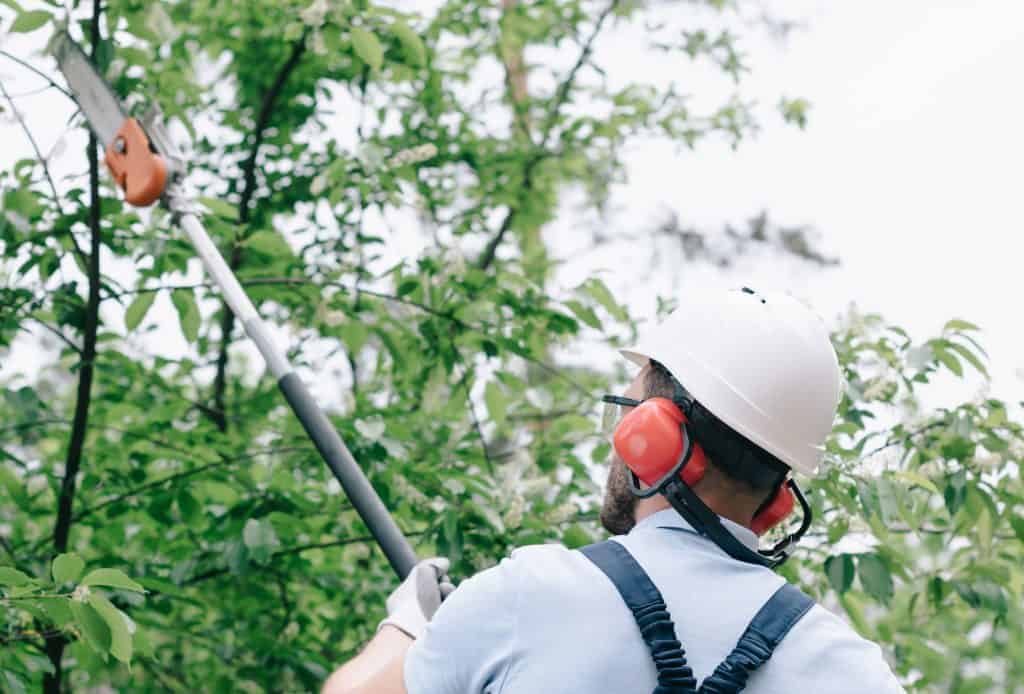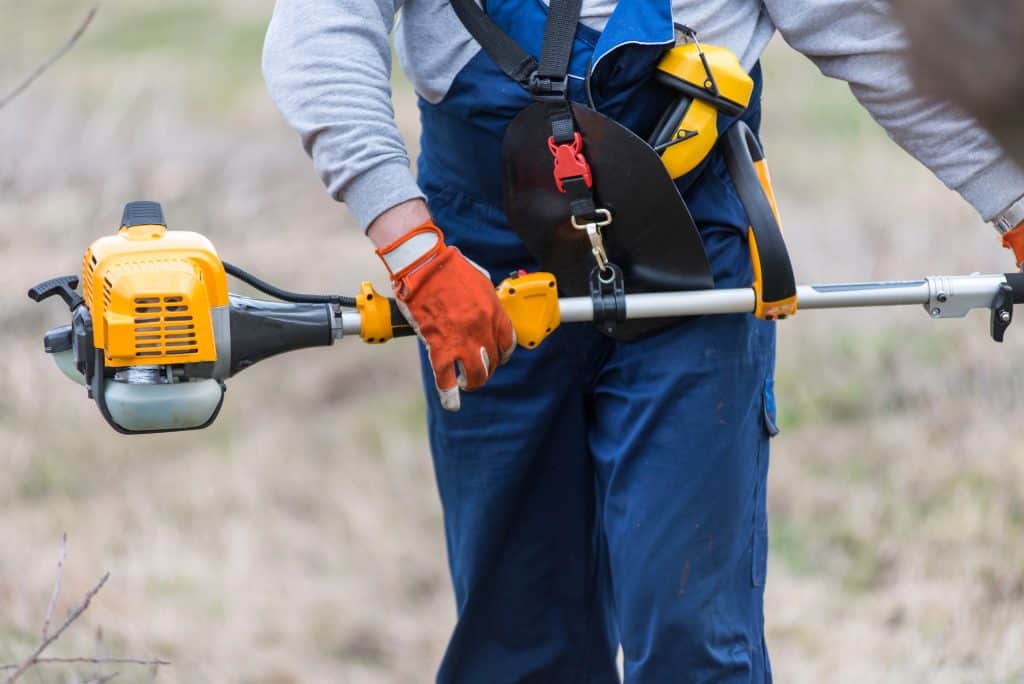Tree pruning and tree trimming involves very delicate procedures. Since it involves cutting or removing large branches, it should be done with both safety and precaution. However, no matter how much you gear up for a safe tree pruning process, if you are not using the proper cutting tool, you are still at a risk. Below is a step by step guide on how to use a pole saw for beginner.
What is a Pole Saw
A pole saw is a reciprocating saw with a long pole as a handle, and is used for pruning or trimming trees. A really good pole saw is handy for cutting vegetation and tree branches that are elevated or out of reach. Its long pole for handle makes it easier for you to cut the branches you want to remove.

Pole Saw Uses
These types of tools come in handy when you need to trim and prune your trees. They won’t work to cut down any trees, but you can use them to cut back any overgrown bushes or trees. We’ll go through each of the uses for this handy tool in depth.
Cutting Branches
The most common use of a pole saw is cutting the branches of a tree. It is also used to cut a bush or a shrub that you cannot reach safely.
Keep in mind that it is dangerous to strain yourself to cut tall branches. Standing on a tall ladder can be dangerous, and a pole saw allows you to reach these branches safely.
Tree Trimming
Rather than just cut a branch or two, you can trim an entire tree back with a pole saw. This is perfect for overgrown trees that have gotten out of control. It also works well when you have a tree that has grown to touch power lines and is a danger.
Tree Pruning
Pole saws are extremely handy when pruning trees. This is because it allows you to reach elevated parts of a tree without having to leave the ladder you are stepping on. It also allows you to reach between branches for the more delicate parts of pruning without the risk of scratching or possibly injuring yourself.
Brush Clearing
Pole saws are also useful for clearing out large growths of brushes, wayward vegetation, and tree branches in the way of paths and construction sites. If you’re going to start on a backyard project, its a good idea to do your landscaping ahead of time.
Though you have to keep in mind that when clearing large brushes and debris, you will need to use a heavy-duty pole saw.
Pole Saw Features
Pole
The standard pole of a pole saw is usually made of steel or fiberglass, with an average length of 10’’. If you need something longer, it is better to get a saw with an extendable pole rather than a longer pole. Keep in mind that the longer the pole, the harder it is to operate. Plus, an extendable pole will save you storage space.
Blade
Pole saws generally have two types: manual and powered.
1. Powered pole saws have moving blades which is ideal when clearing debris or cutting branches. All you have to do is turn on the saw and start cutting.
2. Manual pole saws, on the other hand, have blades that are operated manually with the standard back and forth sawing movement.This can be great when you are doing fine cuts, such as you do with pruning.
Clipper
Most pole saws have clippers that are perfect alternatives to hand pruners or garden clippers. These allow you to delicately trim small branches or overgrown leaves.
Pull Cord
Pull cords are the switch for the clippers. It stretches from the handle area to the clippers.
These typically end with a wood or plastic handle which makes it easier for you to grip and pull on.

How to Choose the Right Pole Saw
There is a variety of options to choose from when looking for a pole saw. To avoid getting confused, you have to consider several things in order for you to know the specifications that you are looking for in a pole saw.
- First of all, you want to have a tool that provides you easy access to high tree branches or nice cutting capabilities. Make sure you understand how high your specific trees are, so you can get a pole that is long enough.
- Second, focus on finding a good “power to weight” ratio. If a pole saw is too heavy, it will make it difficult for you to perform your cutting. Remember, you will be holding the pole saw with your body for long periods. Even if it seems very light at first, it will eventually feel heavy, especially when you are holding it for too long.
There are a variety of different saws to pick from: electric models, corded and cordless models, gas or battery powered and more.
Cordless Pole Saw (Battery Powered)
This version of pole saw uses a battery as the power source and is rechargeable. Most rechargeable pole saw batteries can last between 30 minutes to 1 hour.
Of course, the longevity of the battery life depends on what type of battery is used. Most often these days, battery powered pole saws use lithium-ion batteries since they are known to last longer and have steady power output.
Since this version of pole saw solely depends on rechargeable batteries, they have the lowest amount of power compared to other types of pole saws available in the market. But, there are many other benefits:
- It is very portable.You don’t need an extension cord to power the saw. This is really handy because trees and shrubs can be all over your property, and not having to deal with cords saves you a lot of time and hassle.
- These electrical cord-free saws tend to be a little simpler than over types, and break a little less as a result.
- It is very easy to use. You don’t need to deal with keeping gas on hand, or starting the saw by adjusting the choke. A battery powered option is incredibly easy to use.
Corded Pole Saw (Electric)
Compared to cordless pole saws, this one obviously is tied to a cord since it uses electricity as its power source. You might choose this type of pole saw if you do not mind having to plug and unplug it during and after use. For smaller yards, this might be the perfect option.
Additionally, corded pole saws also pose several benefits. These are:
- They do not need that much of maintenance as well. Since they draw power from an electrical outlet, you do not need to change or refill the oil.
- These are typically the lightest weight of pole saws. This type of saw does not have a fuel tank to refill or battery packs. So, it is much easier to carry and transfer from one place to another.
- Most corded pole saws are not very expensive, compared to battery or gas options.
- Aside from that, you will not need to buy replacements in case the batteries are destroyed or the fuel runs out. Corded pole saws are suitable for outdoor DIY projects too!

Gas Powered Pole Saw
If you are looking for a heavy duty pole saw that is perfect for landscaping and forestry, this is it. The most powerful of all of the different types, a great gas powered pole saw can tackle the toughest of trees and branches.
Landscaping, forestry and home tree pruning involves heavy duty work. Gas powered pole saws are suitable for these types of heavy work because they have very powerful engines and long bars that usually measure 10 to 12 inches.
They also have heavy-duty torque that is also made for heavy workloads. Furthermore, they provide some additional comfort features, like rear-mounted engines to keep it balanced and reduce vibration.
How to Use a Pole Saw
Before you start using your saw to trim and cut back, prepare yourself so that you stay safe.
Safety Preparation
Before you start working, make sure you are fully prepared. You have to ensure that you’re being safe and taking precaution before performing any cutting activity, especially when using a pole saw.
- Heavy tight clothing: To make sure that your whole body is protected, wear some tight clothing. This will keep it from getting caught in the saw. Also choose thick clothing that can protect you from small bits of wood that may scatter in different directions. Some of it may be very sharp and pointed, and fall from a tall tree.
- Boots: To protect your feet from sharp objects that may fall on the ground, wear safety boots. As you cut, a lot of branches and brush will be falling on the ground, and some of it could be sharp.
- Gloves: Protect your hands from a number of different things. First, you might develop blisters from holding the saw without gloves. In addition, you’ll have to be moving fallen brush around, and gloves will protect your hands.
- Eye and ear protection: Keep your eyes protected and wear safety goggles.Make sure that tiny wood particles won’t get into your eyes or you will get them badly hurt. The pole saw also makes some loud noise that can damage your ears. For safety, you can use earplugs.
- A helmet or a hard hat: Again, you’re cutting branches down from tall heights, and you’ll be standing right under these falling branches. While it might sound a bit ridiculous, you really should wear a helmet to protect your head.
Gear Preparation
After preparing yourself for safety, it’s time to prepare your equipment.
- Fill up the pole saw chain oil window (if you are using a gas saw): To start, follow the instructions that are included in the pole saw manual. Also, if you are using a gas-powered pole saw, make sure that your pole saw chain oil is at least halfway up the chain oil window. This is an important step not to miss.
- Clear the area: Your workplace should be free from clutter and other unnecessary objects that may interfere with your work. You’ll be looking up high while you cut, so it is easy to trip over even the smallest of objects.
- Use an outdoor extension cord (if you are using a corded saw): Outdoor extension cords are necessary when you are using an electric-powered pole saw. An outdoor extension cord can be more durable than that of a regular extension cord since it is made for outdoor projects and heavy work. Make sure it is plugged in. Remember to loop the cords to avoid accidents.
Cutting Your Trees and Shrubs
Its now time to begin cutting your trees, shrubs, and bushes. The process is very basic, as you’re just cutting wood branches, but you’re doing it with a 10ft pole between you and the saw.
- Stand in a comfortable and stable position.
- Hold the pole with your working hand, with your thumb wrapped around it and your arm steady.
- If your model has a safety lock, turn it off.
- Then, hold the throttle button, and squeeze the throttle control.
- Guide the blade against the wood with a light and steady pressure.
- Don’t force the blade. When using a manual pole saw, maintain a steady back and forth sawing pace.
- Slow and steady wins the race. Take your time and have patience as you slowly cut through branches and limbs. If your saw meets too much resistance, you might need to switch to using a chainsaw while you stand on a ladder.
- Stay in control and avoid unnecessary movements. Never raise your arms over your head – always keep them at waist level for stability.
- Stand at an angle to the limb you’re working on so you’re not under the pole saw if it falls. Likewise, this way the branch won’t fall on you when its completely cut.
- When using a powered pole saw, press the chain oil bulb every 210-30 seconds while cutting to lube your bar and chain.
- After using a powered pole saw, release the throttle control and let the saw come to a complete stop.
- Pick up all of the fallen branches, leaves, and debris. Depending on what type of tree you were cutting, some of the clippings might be great for your compost bin.
- Keep or store your pole saw separate from other equipment and out of children’s reach when not in use.
Conclusion
Pole saws are easy to operate and incredibly handy. They take a lot of the effort out of trimming your trees, and can save you a lot of money from having to hire professional trimmers. They are a power saw, though, and so you need to make sure to exercise caution and be safe while using this tool.